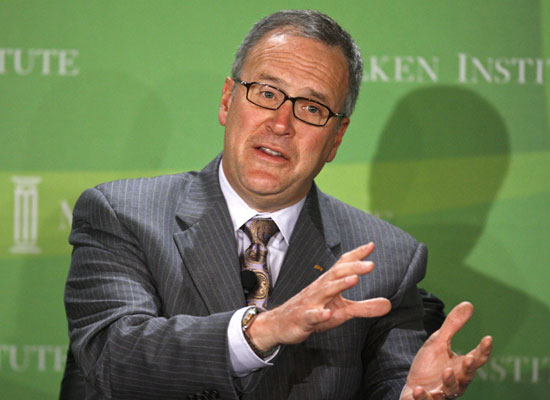Pharma leader wants closer R&D ties
By Liu Jie (China Daily) Updated: 2012-12-01 09:23China 'must maintain innovative climate, do more to ensure fair medicine pricing'
China's medical innovation sector should focus on intellectual property protection, fair medicine pricing, and transparent, predictable regulations aligned with global frameworks, according to one of the US pharmaceutical industry's leading figures.
|
 |
|
John C. Lechleiter, chairman of the Pharmaceutical Research and Manufacturers of America, said his association expects R&D cooperation between its member companies and Chinese counterparts to increase in coming years. [Photo/Agencies] |
John C. Lechleiter, chairman of the Pharmaceutical Research and Manufacturers of America, said his association expects R&D cooperation between its member companies and Chinese counterparts to increase in the coming years.
He said: "It is important that China should maintain a climate for innovation, for the innovative medicines and innovative medical solutions that can be developed for the better lives of people."
The association is a body in the global industry, representing leading US pharmaceutical research and biotechnology companies.
Its members invested an estimated $49.5 billion in 2011 in discovering and developing new medicines, according to its website.
Lechleiter - who is also chairman, president, and chief executive officer of the international pharmaceutical giant Eli Lilly and Company - said China was improving in intellectual property protection, both in terms of patents and data protection. He added "a fair and transparent pricing system that recognizes the value of medicines" is also needed.
In the pharmaceutical industry, highly innovative medicines with patents are priced higher, given the huge R&D costs involved, while generic drugs are generally priced cheaper.
A major focus of China's medical reform, which is aiming to provide universal healthcare for its 1.3 billion population, is to cut the prices of medicine.
But any price reduction requires some degree of squeezing of drugmakers' profit margins.
Lechleiter said that price policy had "really impacted" on his members, explaining that innovative drugs usually take 10 to 15 years to develop, and cost an average of $1.2 billion in R&D costs.
According to a recent report China's medical reforms, international market research firm McKinsey & Co said that despite affordable medicine being a government policy, enterprises still need profit to pay for the necessary R&D.
It added that finding a balance between the two is a challenge to both the country's decision makers and the main businesses involved.
Lechleiter urged that a regulatory system should be introduced in China to allow foreign companies "to undertake clinical trials, to achieve regulatory approval for new medicines in a way that is more harmonized with other countries, and which will enable Chinese patients to access new medicines, sooner".
Multinational drugmakers, including those from the United States, have been fighting hard to be allowed to introduce their latest products to emerging markets in recent years.
China is now the world's third-largest pharmaceutical market, and is expected to become the second after the US by 2017.
China has strict market-access regulations due to medical safety concerns, so many new products don't end up being sold in the country until two to three years later than they become available in developed markets, such as the US, Europe and Japan.
The preferred route for many multinationals has been to carry out R&D in cooperation with Chinese drugmakers.
Guo Fanli, a senior pharmaceutical researcher with local market research institute China Investment Consulting Co Ltd, said: "Cooperation not only helps foreigners develop locally tailored products, but also facilitate their market access, by using the resources of local partners."
Lechleiter said cooperation can take many forms, including R&D partnerships, license or equity agreements, or joint ventures.
"Chinese companies are growing up, and we expect the number of these kinds of agreements to increase," he said.
The environment in China is favorable for Chinese R&D-oriented drugmakers.
The biopharmaceutical sector was set by the central government as one of the seven key developing industries during the 12th Five-Year Plan (2011-15), with tens of trillions of yuan earmarked for R&D support to the sector.
liujie@chinadaily.com.cn
- China maintained stable growth in Q2: UBS
- A glance at Sony's PSVR
- Chinese building giant joins China's biggest tourism project in New Zealand
- China to inspect local govts following private investment slowdown
- Bright future for Hanergy solar cars
- Gold investment rebounding in China
- Central bank drains 180b yuan from market
- Spending on luxury goods slows


















